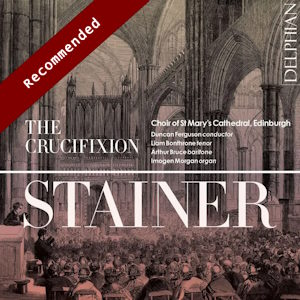
John Stainer (1840-1901)
The Crucifixion (1887)
Liam Bonthrone (tenor), Arthur Bruce (baritone)
Imogen Morgan (organ)
Choir of St Mary’s Cathedral, Edinburgh/Duncan Ferguson
rec. 2023, St Mary’s Episcopal Cathedral, Edinburgh
Delphian DCD34275 [69]
This famous old warhorse was a popular favourite in later Victorian times and continued so until things Victorian fell out of fashion. It has taken some time to be restored to favour, though there are now several recordings. I don’t know how often it is performed nowadays; I have only once heard a live performance.
Stainer was no hack but an active and effective church musician who did sterling work at Magdalen College, Oxford, St Paul’s Cathedral, London, and elsewhere as well as composing music of various kinds for church use. A formative experience for him was taking part in a performance of Bach’s St Matthew Passion while still a chorister, and The Crucifixion is clearly a work in the Bach tradition but deliberately and skilfully written to be much shorter and easier to perform. He intended it for parish choirs with organ accompaniment and only two soloists are required, who need to be of professional standard. The libretto is by William Sparrow Simpson, who had won a prize for English verse as an undergraduate and later became a clergyman and a colleague of Stainer’s at St Paul’s. He constructed it from passages in the New Testament, other traditional material such as the Reproaches sung on Good Friday, together with work of his own which is not unworthy of its setting.
The music is in twenty numbers, which are variously recitatives, solos or duets, choral passages, and congregational hymns, of which there are five. The idiom is a conservative one for the time, which would not have astonished Brahms or even Mendelssohn, and is nowhere near the anguished chromaticism of Wagner’s Parsifal of a few years earlier. However, it is not pompous or stodgy, gets the story told well and is easy and pleasant to listen to. Although not a great work it is a good one and deserves a good performance.
That it certainly gets here. Duncan Ferguson has his cathedral choir to carry the choral sections, and they are strengthened by others, including the cathedral congregation, for the hymns, which is entirely proper. He also ensures that the music moves along without the risk of getting bogged down. The two soloists, the tenor Liam Bonthrone and the baritone Arthur Bruce, are rising stars both on the operatic stage and in concert and they have the right kind of voices and delivery for their roles. I should explain that, unlike, Bach, Stainer did not designate one voice as the evangelist and another as Jesus, but varied the voices, so that, for example, Jesus’s words are sung sometimes by the bass and sometimes by the chorus. The soloists have a good deal of work and also an impressive duet, ‘So Thou liftest Thy divine petition’ at about halfway through. I should also mention Imogen Morgan’s sensitive support on the organ.
The recording, made in the cathedral, is fine and resonant without excessive reverberation and the booklet, from which I have drawn, is very helpful. Jeremy Dibble, who wrote it, is the leading authority on Stainer and edited the edition of the work that is performed. There are other recordings, which I have not heard, but I find it hard to believe that they could be better than this one. Indeed, it seems to me an ideal performance, which does the best for the work.
Stephen Barber
Help us financially by purchasing from


















